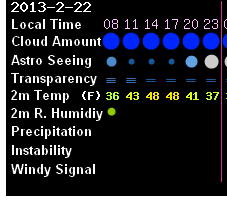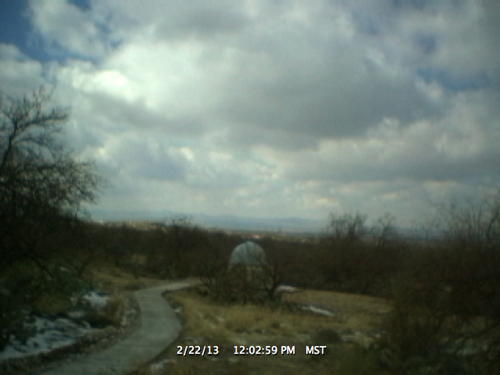
Snow; HST-Sun Transit Imaging Attempt
Posted: 22 February 2013
A winter storm and snow arrived in Oracle about noon on Wednesday, 20 February 2013. I posted four six-second video clips on Twitter Vine:
Clip 1
Clip 2
Clip 3
Clip 4
Received 2.5" of snow in the first wave, with additional accumulation in a second wave as sunset approached. A time-lapse video from my live webcam of the day's weather was also posted. Thursday morning after sunrise I took this panorama showing the 3-to-4" of snow that fell on Oracle and across the entire southern Arizona area. The photo was taken using a D7000 DSLR at a focal length of 25mm and cropped. The view is towards the west, showing Kitt Peak (visible beyond the observatory) and snow covered mountains and valley. Click to see a larger version.

This closer view shows Kitt Peak to the right and behind my observatory. You can see some structures on the mountain, most notably the dome of the 4-meter Mayall telescope.

The snow mostly melted during the day. A time-lapse video of the melting snow (and some bonus snow photos) was posted. I removed snow from the observatory dome in the afternoon and returned to the observatory about sunset to sync the observatory clock to WWV. The sky was cloudy Thursday night.
Earlier in the week, CalSky.com had sent me an alert for a Hubble Space Telescope (HST) Sun transit on Friday, 22 February 2013. Although the HST would be small (2.6"), the transit would be nearly equatorial on the sun and over 2 seconds in duration.

The forecast for all day on Friday was for clear skies:

But mid-day, the sky didn't look very promising:

I decided to go to the observatory and get ready in case the sky cleared in time for the HST-Sun transit. The observatory was opened Friday. 22 February 2013, at 1459 MST, 62°F. There were clouds in most of the sky, but there were a few clear areas. I attached the Orion solar filter to the 8" LX200-ACF and using the "Sun as Asteroid" technique, did a GOTO the Sun. Three small sunspots were visible at 77X.
Switched to the visual back and mounted the D7000 DSLR at prime focus. I then several test HD video recordings and still images at various shutter speeds and ISO settings. I decided to use 1/1600sec at ISO 1000 for the HST-Sun transit. Focusing was difficult due to poor seeing, but at least the clouds stayed away from the sun.
Sixteen minutes prior to the transit, I took this self-portrait with my iPhone 4:

I started the HD video recording at 1553 MST, a little over one minute prior to the predicted transit time, and let it go until one minute after the transit was over. The clouds stayed away from the sun. Did I capture the small HST? That would have to wait until I checked the video on the computer.
The observatory was closed at 1606 MST, 56°F.
I reviewed the video on the computer, but the HST was not visible in any of the frames. It would have been very small at prime focus, and with the poor seeing, it could have been blurred out as it transited the sun. This is what an enhanced frame looked like:

Had the HST been visible, it would have crossed horizontally across the middle of the image. It would likely not have been visible at this scale, but magnification of the image might have shown it. But it was no where to be found. Anyone reported a missing Hubble Space Telescope?
Comments are welcome; use the Comments section below, or you can Email Me. Thanks.
Go to the previous report.
Return to the Cassiopeia Observatory Home Page.